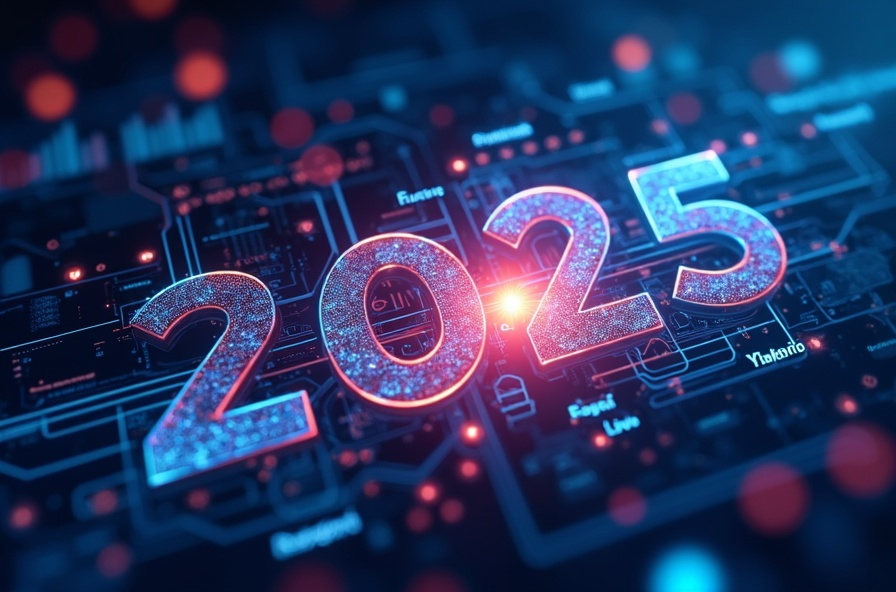
Introduction
The marketing landscape is evolving at an unprecedented pace, shaped by groundbreaking technological advancements and shifting consumer expectations. From the transformative influence of AI to the increasing importance of privacy-centric strategies, marketers face both significant challenges and exciting opportunities. As we kickoff 2025, staying competitive will demand not just adaptation but innovation at every turn.
In this blog, we delve into the key trends and predictions that we believe will redefine marketing—providing actionable insights to help you navigate this dynamic landscape with confidence. Additionally, just for fun, all of the images you find in this blog were created entirely by AI. You can find the prompts used directly below each image.

The prompt used to generate this image: (marketer and AI collaboration), dynamic workspace that includes both a human marketer and representation of AI, a mix of (high-tech gadgets) and (creative chaos), (light and shadow interplay), (cool tone) lighting highlighting brainstorming materials, intense expressions of focus, a blend of intrigue and frustration, mood reflecting competitive tension, (4K ultra-detailed) illustration capturing the essence of modern marketing challenges.
1. AI Will Make Breakthrough Marketing Harder
We’re all using AI tools in some capacity, and as the tools improve AI will likely streamline and enhance greater portions of the marketing workstream. However, in our view, the ubiquity and similarity of AI output is going to make effective marketing more challenging in 2025 and beyond.
Beware the AI “Class System”
I recently had a conversation with another boutique agency owner who has been working in AI for at least 10 years. He’s developed his own tech, perfected his own models, and has a number of clients who enjoy his work. His entire team has also been hired out from under him multiple times due to their skill sets and larger clients’ ability to pay.
The point I want to make with this story is that we’re likely entering a period of AI haves and have-nots. The AI haves can afford to build or purchase their own models, spend the time training those models to speak in their brand voice and respond with funnel-optimized prompts, and feed the models massive amounts of data to optimize for performance continually. These models will need a small team to get up to speed and monitor and can cover massive amounts of digital ground wherever potential demand may exist.
The AI have-nots will be using off-the-shelf tools to create assets and responses and have their own data accessible, and while they too will realize efficiencies, it will become harder to compete with larger, better-trained models supported by bigger budgets.
My expectation is that the smaller your business, the harder you’ll have to fight to maintain awareness and reach.
Search Evolution
AI-driven search is fundamentally changing how users find information. Tools like ChatGPT and other conversational AI platforms are reshaping traditional search queries by providing personalized, curated results. However, these innovations are dramatically impacting organic traffic. A study by Seer Interactive found that organic clicks dropped by as much as 70% when AI summaries were included in search results. Such declines pose serious challenges to organic marketing strategies, often requiring costly paid campaigns to recover visibility. (Seer Interactive). As Rand Fishkin, a noted SEO expert, has said: “The SEO opportunity pie is shrinking.“
Strategies to Adapt:
- Broaden Awareness Campaigns: Evidence suggests Google heavily weighs user behavior. Driving traffic to your LinkedIn profile or other external sites can positively influence your rankings.
- Embrace Multimedia Optimization: Optimize content for video, voice, and visual search to align with evolving search preferences. (Moz)
- Focus on AI Recommendation Sets: Invest in appearing in AI-generated result sets, both organically and through paid placements, to secure a presence in this evolving search ecosystem.
As AI-driven search continues to grow, marketers must adapt by diversifying strategies and investing in new methods of visibility to remain competitive.
Campaign Management and Optimization
AI will enable automated adjustments in campaign targeting, messaging, and bidding across any programmatic platform (social, pay-per-click, and more). Predictive analytics will allow marketers to stay ahead of trends, offering a significant edge in a competitive space.
This approach will help support optimizations but may come with some risk as well due to AI’s reliance on existing data. While these systems will tell you what campaigns or geographies perform better, they will not be able to add a human interpretation to the data and will still require human input to test and evaluate potential creative approaches. Their creation engines will be based on what currently exists in the market, and overreliance on them can make you look very similar to your competitors.
Where Will AI Continue its Growth?
Creative Innovation
AI is also revolutionizing creative processes, enabling the production of assets like videos and written content at unprecedented speed. However, marketers must evaluate whether AI-generated assets perform as effectively as human-created content.
Pros:
- Scalability and Cost-Efficiency: AI enables rapid, cost-effective content creation. For instance, AI-generated models in advertising have streamlined campaigns while maintaining profitability. (Washington Post)
- Personalization: AI tools tailor content to individual preferences, boosting engagement and customer satisfaction. (Harvard Business Review)
Cons:
- Authenticity and Brand Voice: AI content can lack the emotional depth and nuanced understanding of brand identity that human creators bring, risking audience disconnect.
- Consumer Skepticism: Studies, like those from Washington State University, reveal that labeling products as AI-generated can reduce purchase intentions.
- Ethical Concerns: Overuse of AI-generated content risks diluting quality and raises concerns about job displacement in creative industries.
While AI offers scalability and personalization, marketers must balance these benefits with the need for authenticity and ethical practices, and the irreplaceable value of human creativity and emotional intelligence. The unique insights, nuanced storytelling, and ability to forge genuine connections that humans bring remain essential in crafting campaigns that resonate with audiences and build long-term trust.

The prompt used to generate this image: (confused marketer), sitting in front of a computer, overwhelmed expression, vibrant colors, dynamic composition, chaotic array of marketing networks, digital notifications exploding from the screen, modern office background, cozy yet chaotic atmosphere, ultra-detailed visual, warm lighting, engaging and expressive scene showcasing the complexities of digital marketing, high quality, 4K resolution.
2. Audience Fragmentation and Challenges with Reach
We expect marketers to run into reach challenges as audiences fragment and adopt new platforms. Impression volume from any single source will likely decline in 2025 and beyond as users retreat behind closed communities that do not report metrics with the same transparency as Google, which itself will likely lose share to AI search competitors.
Navigating Fragmented Platforms
Social media is now essential for brand visibility, but platforms are fragmenting as users grow tired of heavy ad volume, decreasing utility, and a lack of control over their own experience. Note that teen usage of many social media sites is flat or declining, while services that provide closed, self-hosted communities such as WhatsApp or Discord continue to see growth.
Increasingly, we expect that users will browse smaller, closely moderated communities instead of a one-size-fits-all site. And while these communities will likely evolve more targeted ad tooling, they are hard to target at scale due to a lack of known user information or affinities to any content or behavior outside of the specific topic at hand.
To maintain reach in the future, we recommend that marketers:
- Participate in new communities as a user first to understand their interactions and develop tailored strategies and content.
- Address declining organic reach by prioritizing paid placements and influencer partnerships.
The Future Beyond Google
Google currently owns more than 90% of traditional search traffic, but traditional search traffic is likely collapsing. According to the Wall Street Journal, Google’s share of overall search, including product search, AI search, and other modes, will likely drop to 50% in 2025. That means that marketers will need to explore alternative digital ecosystems to maintain the same reach that a Google PPC campaign might have been able to provide. Strategies may include:
- Investing in niche platforms. Explore niche platforms like Reddit, Etsy, and Substack, and dive into emerging spaces such as Twitch, Nextdoor, and AI-driven platforms to uncover unique opportunities and stay ahead in the evolving digital landscape.
- Testing your content across AI search engines such as OpenAI to understand your rankings
- Diversifying ad spend across emerging search engines and marketplaces such as Perplexity AI.

The prompt used to generate this image: (Marketer Deep in Thought), intense focus, surrounded by (abstract symbols of privacy), such as locks and shadows, cool tones with hints of deep blue and black for seriousness, soft and diffused lighting, modern and sleek atmosphere, portraying a blend of strategy and protection, high-quality, ultra-detailed representation, conveying a sense of reflection and contemplation on privacy in marketing.
3. Data Changes in a Privacy-Centric World
Marketing metrics will get more fuzzy in a privacy-centric world as more users decline consent, opt-out, or block all tracking entirely. While these regulation-driven changes are a boon for web users, our experience shows that consent-enabled platforms experience about a 50% decrease in visitor data reporting. As a result, we expect them to return marketers to the early days of analytics where more direct testing and measuring was required in order to assess the true impact of campaigns and activities.
Overcoming Tracking Challenges
Stricter privacy regulations have forced analytics providers to provide tracking opt-outs for visitors, meaning that your analytics will try to compensate by relying more on modeled data from the users who do consent to tracking. This modeled data will be less accurate, but you can overcome these issues by adopting a few tactics:
- Establish URL UTM coding for every link you create: this will ensure the most accurate level of campaign-specific tracking that you’ll be able to receive, and will record even for visitors who opt out of tracking
- Drive as much traffic as possible to your site and landing pages: the more traffic and event data a tool like Google Analytics receives, the better its modeled data will reflect reality
- Focus on event count, versus traffic and users: You may need to shift your top-of-funnel metrics a bit further down your funnel, to data like lead submissions, to get better quality data. While you will still have impressions and traffic figures to report, they will not reflect the true nature of your efforts and may see significant swings depending on the volume of site traffic you see.
- Create as much first-party data as possible: encourage user consent and information submission as much as possible. Doing so allows you to harvest the highest quality data and use it for remarketing purposes.
- Experiment with audiences: with privacy restrictions preventing ad platforms from sharing session data with you, they have tried to compensate by providing you with audience targeting options that may help you improve performance.
- Connect to your analytics API: server and API data can give you more accurate event data. Google, for example, still sends “cookieless pings” for events that are triggered by non-tracked users.
Conclusion
The marketing landscape of 2025 will bring significant challenges and opportunities. AI is transforming the industry, offering scalability and efficiency while raising concerns about authenticity and widening the gap between those with advanced tools and those relying on basic solutions. Audience behaviors are also shifting, with fragmented platforms and AI-curated search reshaping visibility.
To succeed, marketers must adapt. Embrace multimedia content, optimize for AI systems, and explore alternative platforms beyond Google. Prioritize first-party data and trust-building strategies to navigate privacy changes. By staying agile and audience-focused, marketers can remain competitive and relevant in this evolving digital space.
Have questions about adapting to these changes? Contact us for a consultation or explore our resources to future-proof your marketing strategies.
AI Tools to Help Your Productivity. Which ones did we miss?
Text:
- ChatGPT – AI chatbot for various tasks.
- Notion – Enhances Notion notes with AI.
- Writesonic – Generates written content using AI.
- INK for All – AI-powered SEO content writing assistant.
Images:
- Midjourney – AI-powered image editing.
- Leap – Enhances image quality with AI.
- Stockimg AI – AI-generated stock images.
- Artbreeder – AI-driven image creation and editing, perfect for custom visuals.
Videos:
- HeyGen – AI video generation tool.
- Descript – Video editing with AI transcription.
- Runway – Create interactive video experiences using AI.
- Pictory – Converts long-form content into short, engaging video clips using AI.
Research:
- Perplexity – AI-powered research assistant.
- Alicent – Automates research tasks using AI.
- Rose AI – AI for research and content creation.
- Synthesia – Uses AI to create video content from research and text inputs.
Audio:
- LOVO AI – AI voice and audio generation.
- ElevenLabs – Audio processing with AI.
- Adobe Podcast – Audio editing and podcasting with AI.
- Descript – Also an AI tool for podcast editing and transcription.
Productivity:
- Text Blaze – Text expansion and automation.
- tl;dv – AI Meeting Assistant – Summarizes lengthy texts using AI.
- Eightify – AI-powered time management.
- Zapier – Automates workflows between apps using AI.
Presentation:
- Decktopus AI – AI-powered presentation creation.
- Design AI – Graphic design automation.
- Beautiful.ai – AI-powered presentation design.
- Tome – AI-driven storytelling tool to create presentations, reports, and documents.
Website:
Share this post on your social profile:
A performance-driven marketing strategist with twenty years of experience growing international brands and organizations, Tim Young spent time at the Corporate Executive Board (now Gartner) and the Entrepreneurs' Organization before founding Young Marketing Consulting in 2013.
His areas of expertise include brand growth and identity development; lead generation and conversion; search engine optimization (SEO); customer satisfaction evaluation and improvement; customer segmentation and CRM work; ROI analysis and improvement; market research; and product development.
Want to get our blogs directly to your inbox?
Enter your email to sign up for our point of view on marketing trends, brand strategy, and sustainable business.


